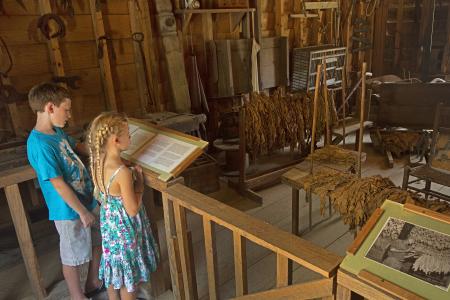Among the Carolina pine trees along US 301 just off I-95, Exit 107, stands the Tobacco Farm Life Museum. The museum's existence is a testament to the farming community in the area. Without the prosperity that flue-cured tobacco farming brought to North Carolina, many farmers would have lost their land. Since the late 1800s, tobacco would out perform all other crops like cotton, soybeans, and sweetpotatoes.
Our museum and grounds are the perfect way to step back in time. Enjoy the 6,000 sq. ft. gallery with permanent and rotating exhibits on farm life, southern medicine, domestic skills, rural social life, textiles, early transportation and more. Don't forget to stop and sit on the front porch before touring the grounds.
The historic buildings on site include the Iredell Brown Homestead with detached kitchen, a tobacco barn, a smokehouse, and a one-room schoolhouse from a nearby community, as well as reconstructions of a packhouse and working blacksmith.
History of the Museum
In 1983, area farmers started giving guided tours of their tobacco farms to visitors interested in learning about bright leaf tobacco. Local farm families donated farming tools and equipment to the museum, some of which had been used for decades. Visitors were fascinated, and the tours grew in popularity.
The exhibits at the museum portray the importance of tobacco, ranging from early harvesting techniques to soil conservation and tobacco advertising from the 1930s. In 1989, the museum set out to assemble an exhibit of an entire farmstead, including an authentic log tobacco barn, farm house, kitchen, and smokehouse, which were all restored to their original beauty and relocated to the shady pine grove at the museum site.
To better portray the importance of tobacco to visitors, the museum set out in 1989 to assemble an exhibit of an entire farmstead on the site of the museum. An authentic log tobacco barn, farm house, kitchen, and smokehouse were restored to their original beauty, and relocated to the shady pine grove at the museum site.
In one of the farmstead’s quaint bedrooms, you’ll find authentic period rugs and bedspreads actually made from used tobacco twine. The museum's archives have grown to include a large collection of farm tools and equipment, schoolhouse mementos, decades-old musical instruments, household goods, as well as Depression Era medical and dental tools.
A most intriguing exhibit is a collection of artifacts from the Tuscarora Indians. They are believed to be Johnston County’s earliest settlers, and raised tobacco in the area as well. The collection includes priceless clay trading pipes used for bartering by early settlers.
From the clothes they wore to the tools they used, visitors are given a unique perspective into the life of a North Carolina tobacco farmer. Well over 10,000 visitors a year get a chance to experience farm life of days-gone-by at the museum. The museum hosts rural art exhibits, and weekly Heritage Day themed events. Thousands of school children have visited the Barnes Crossroads one-room school and experienced the simple learning tools used like chalk and small blackboards.





